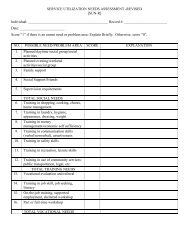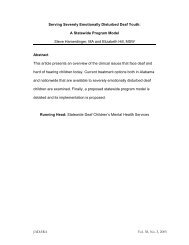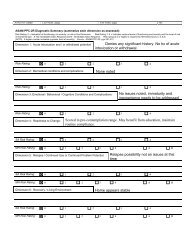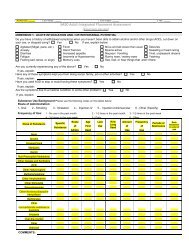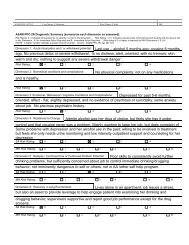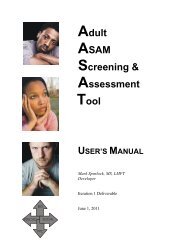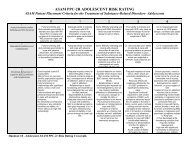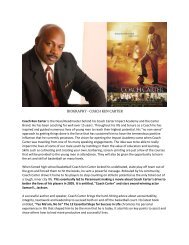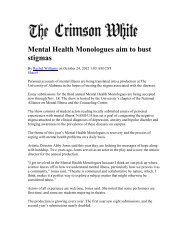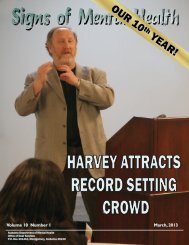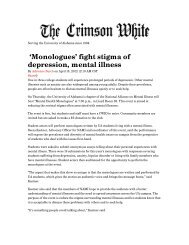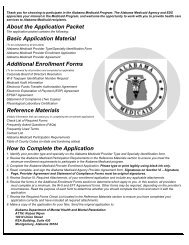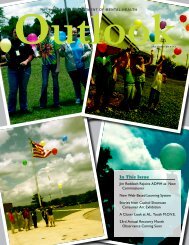Volume 7 Number 2 May, 2010 - Alabama Department of Mental ...
Volume 7 Number 2 May, 2010 - Alabama Department of Mental ...
Volume 7 Number 2 May, 2010 - Alabama Department of Mental ...
Create successful ePaper yourself
Turn your PDF publications into a flip-book with our unique Google optimized e-Paper software.
State Gets Deaf Emergency Preparedness TrainingThe <strong>Alabama</strong> Emergency Management Agency partnered withthe Office <strong>of</strong> Deaf Services and the <strong>Alabama</strong> <strong>Department</strong> <strong>of</strong>Rehabilitative Services to make available training for the deafcommunity and first responders conducted by theCommunity Emergency Preparedness Information Network(CEPIN). The training was held April 1, <strong>2010</strong> in Montgomery.Forty-four participants from a range <strong>of</strong> state and localagencies, as well as the Deaf Community attended the eighthour event, which was held at the <strong>Alabama</strong> <strong>Department</strong> <strong>of</strong>Rehabilitation Services <strong>of</strong>fice in Montgomery. ODScoordinated the logistics and communication access. Otherstate agencies collaborating in the effort included the<strong>Alabama</strong> <strong>Department</strong> <strong>of</strong> Public Health and the <strong>Alabama</strong>Institute for the Deaf and Blind.CEPIN has been providing specialized training for over sixyears. The course, Emergency Responders and the Deaf andHard <strong>of</strong> Hearing Community: Taking the First Steps toDisaster Preparedness, was developed pursuant a grant fromthe U.S. <strong>Department</strong> <strong>of</strong> Homeland Security.CEPIN trainers, Andy Pelham and Christine Seymour,conducted the training which was intended to provideparticipants with an understanding <strong>of</strong> the tools andknowledge needed to prepare a community response fordeaf, hard <strong>of</strong> hearing, late-deafened, and deaf-blindindividuals, as well as respond to and recover fromemergencies ranging from weather-related emergencies to aterrorist attack. Seymour is the Emergency PreparednessRegional Specialist for the Western U.S. and Hawaii for CEPIN(Community Emergency Preparedness Information Network)as part <strong>of</strong> a national team that developed the course.Pelham is a trainer for the U.S. <strong>Department</strong> <strong>of</strong> Energy(National Nuclear Security Administration's Counter TerrorismOperations Support).<strong>Alabama</strong> is well ahead <strong>of</strong> most states in plans for assistingdeaf people in times <strong>of</strong> disaster.This is the second time CEPIN has done training in <strong>Alabama</strong>.The first time was almost exactly three years earlier (March30, 2007). CEPIN Program Director, Neil McDevitt, was effusivein his praise. "I've heard nothing but verypositive things from our instructors and Glenna about theparticipants. CEPIN is grateful for the opportunity to goaround the country and teaching in wonderful places likeMontgomery, AL. We believe preparedness is critical foreveryone but no one can do it alone. Emergency managersand responders need to sit in the same room as deaf andhard <strong>of</strong> hearing people and learn from each other." Deaf and hearing participants had to work through how tocommunicate even if an interpreter was not present. It was a “real-life”exercise in how to make plans for including deaf people in emergencyresponse. Clockwise from the left: Glenda Harris, ADPH; Stephan Mambazo,ADPH; Frances Ralston, ADMH; Shannon Reese, ADMHSigns <strong>of</strong> <strong>Mental</strong> Health 4
Supersite Aids in Testing for State InterpretersThe <strong>Department</strong> <strong>of</strong> <strong>Mental</strong>Health, Office <strong>of</strong> DeafServices is taking aleading role in assuring allpeople who are Deaf in thestate <strong>of</strong> <strong>Alabama</strong> receivequality interpretingservices. Recently, ODShas, in partnership withthe <strong>Alabama</strong> Institute forthe Deaf and BlindRegional Center inTuscaloosa, opened aNational Testing SystemSereta Campbell, Region III Interpreterand ODS Supersite CoordinatorSupersite. It is the only one in <strong>Alabama</strong> and one <strong>of</strong> the fewin the southeast.The National Testing System is the process for demonstratingpr<strong>of</strong>essional competence leading to certification by theRegistry <strong>of</strong> Interpreters for the Deaf (RID), the leading signlanguage interpreter certification in the United States.The National Testing System includes the NationalInterpreter Certification (NIC) Interview and Performanceexam and all CDI, SC:L and OTC exams. The NIC exam is ajoint testing system between the Registry <strong>of</strong> Interpreters forthe Deaf and the National Association <strong>of</strong> the Deaf.Supersites are authorized administrators for all certificationexams listed.An RID Supersite is a facility that partners with the Registry<strong>of</strong> Interpreters for the Deaf to administer certification testsfor interpreters. Testing sites are located around the country.Each testing site has a site coordinator to serve as themain contact for the site. Site coordinators are responsiblefor maintaining a secure location for the test materials andscheduling testing slots with candidates. Site coordinatorsalso schedule Local Test Administrators (LTA), or serve as theLTA, for all tests and ensure adequate testing facilities andequipment is available to <strong>of</strong>fer the tests.Testing sites <strong>of</strong>fer at least 50 performance test slots per yearand also <strong>of</strong>fer the written portion <strong>of</strong> the test twice per year.Opening the supersite is not the only benefit for interpreters in<strong>Alabama</strong> that has grown out <strong>of</strong> ODS's commitment toimproved interpreter quality. The <strong>Alabama</strong> <strong>Department</strong> <strong>of</strong><strong>Mental</strong> Health has been deeply involved in the establishment<strong>of</strong> the new four-year Interpreter Training Program at TroyUniversity.ODS also established the internationally recognized <strong>Mental</strong>Health Interpreter Training Program (MHIT). The annualInterpreter Institute, one <strong>of</strong> the several projects <strong>of</strong> MHIT, is a40-hour intensive training specializing in mental healthinterpreting that leads to a specialty certification as a Qualified<strong>Mental</strong> Health Interpreter. This year, the 8 th annual class willrun July 25 - 30, in Montgomery.Since its establishment nearly 8 years ago, the Office <strong>of</strong> DeafServices has made it a priority to raise expectations <strong>of</strong>interpreters and to help them meet those expectations.Collaboration with other agencies make possible anenvironment that provides the necessary tools to guideinterpreters in areas such as skill enhancement, good ethicaldecision-making skills, competency in specialized areas suchas mental health and legal interpreting and ultimatelynational certification. ODS looks forward to continuing to <strong>of</strong>ferworkshops and trainings on a variety <strong>of</strong> topics designed toencourage interpreters toward continuous improvement. CURRENT QUALIFIED MENTAL HEALTH INTERPRETERSBecoming a Qualified <strong>Mental</strong> Health Interpreter in <strong>Alabama</strong> requires a rigorous course <strong>of</strong> study, practice, and examination that takes most people nearly ayear to complete. It involves 40 hours <strong>of</strong> classroom time, 40 hours <strong>of</strong> supervised practica and a comprehensive examination covering all aspects <strong>of</strong> mentalCharlene Crump, MontgomeryDenise Zander, WisconsinNancy Hayes, RemlapBrian McKenny, MontgomeryDee Johnston, TalladegaDebra Walker, MontgomeryLisa Gould, MobileGail Schenfisch, WyomingDawn Vanzo?, HuntsvilleWendy Darling, PrattvillePat Smartt, SterrettLee Stoutamire, MobileFrances Smallwood, HuntsvilleCindy Camp, JacksonvilleLynn Nakamoto, HawaiiRoz Kia, HawaiiJamie Garrison, WisconsinVanessa Less, WisconsinKathleen Lamb, WisconsinDawn Ruthe, WisconsinPaula Van Tyle, KansasJoy Menges, OhioJudith Gilliam, TalladegaStacy Lawrence, FloridaSandy Peplinski, WisconsinKatherine Block, WisconsinSteve Smart, WisconsinStephanie Kerkvliet, WisconsinNicole Kulick, South CarolinaRocky DeBuano, ArizonaJanet Whitlock, GeorgiaSereta Campbell, Tuscaloosa5 <strong>Volume</strong> 7 <strong>Number</strong> 2
Overcoming Communication Barriers… The Missing PieceBy Jessica Edmiston,Special Projects Consultant<strong>Alabama</strong> Institute for theDeaf and BlindPhoto by Lisa Sams, AIDBThe human brain is like a mosaicintricatepieces constructed t<strong>of</strong>orm a larger work <strong>of</strong> art. Onemissing component cancompromise the entire work.Thus, when working with children and youth struggling withemotional and behavioral issues, <strong>Alabama</strong> Institute for Deafand Blind (AIDB) Health and Clinical Services and <strong>Alabama</strong><strong>Department</strong> <strong>of</strong> <strong>Mental</strong> Health (ADMH), Office <strong>of</strong> Deaf Services(ODS), pair expertise and resources to restore whatsome might describe as the missing piece.Recently, the two agencies came together under a distinctprogram, Overcoming Communication Barriers, supported bySenator Richard Shelby and administeredby AIDB through the Office <strong>of</strong>Juvenile Justice and DelinquencyPrevention, Office <strong>of</strong> JusticePrograms, U.S. <strong>Department</strong><strong>of</strong> Justice. Withinthe program, 30students who aredeaf, blind and multidisabledand at-risk<strong>of</strong> dropping out orlosing their placementin AIDB’sresidential schools orwithin west <strong>Alabama</strong>school systems, receiveindividualized counselingand case managementservices in school, athome and in their communitiesthrough AIDB’sTalladega-based residentialfacilities and statewide network <strong>of</strong>Regional Centers. A school-based mentoringcomponent matches participants with mentors who alsohave disabilities or experience in the rehabilitation orspecial education fields. In addition to ADMH, West <strong>Alabama</strong>Local Education Agencies, the <strong>Alabama</strong> <strong>Department</strong> <strong>of</strong>Rehabilitation Services, <strong>Alabama</strong> Association <strong>of</strong> the Deaf,Talladega and Tuscaloosa County Jails, Mentor <strong>Alabama</strong>, <strong>Alabama</strong><strong>Department</strong> <strong>of</strong> Economic and Community Developmentand <strong>Alabama</strong> <strong>Department</strong> <strong>of</strong> Public Safety have supportedprogram components.“Students who are deaf, blind and/or multidisabled encounterthe same mental health needs as their peers withouthearing loss: substance abuse, suicide, social acceptance,academic fluctuations and behavioral issues,” explains AIDBPresident Dr. Terry Graham. “In fact, there are multiple definitions<strong>of</strong> ‘at-risk’ and multiple numbers <strong>of</strong> model ‘at-risk’ programs.However, few—if any—specifically target students withsensory and multiple disabilities and the communication barriersthat exacerbate the issues.”“Specifically speaking <strong>of</strong> hearing loss, a true continuum <strong>of</strong>culturally affirmative care for deaf children means that servicesare available in a variety <strong>of</strong> settings and are customizableto meet their specific clinical needs. Ideally, there shouldbe a range <strong>of</strong> services available in the home and in theschool. It also means that such a program would have strongties with schools serving deaf students. Regrettably, this israrely the case, yet this is whatmakes Overcoming CommunicationBarriers structurallystrong,” states ADMH ODSDirector SteveHamerdinger, whoprovides oversight to1,700 deaf and hard<strong>of</strong> hearing peoplewho receiveservices in statoperatedfacilitiesand certifiedcommunity-basedprograms.Hamerdinger, who isdeaf and fluent in AmericanSign Language (ASL),explains that it has beenlong debated whether deafnessis a risk factor for emotionaland behavioral disorders. In a reportentitled “Serving Severely Emotionally Disturbed Deaf Youth:A Statewide Program Model” co-written by Elizabeth Hill, theycite, “Those who are strong advocates <strong>of</strong> the cultural view <strong>of</strong>deafness may bristle at the idea that people with hearing loss(Continued on page 8)Signs <strong>of</strong> <strong>Mental</strong> Health 6
SLPI Training Pulls State Agencies TogetherThe <strong>Department</strong> <strong>of</strong> <strong>Mental</strong> Health (ADMH), the <strong>Department</strong> <strong>of</strong>Vocational Rehabilitation Services (ADRS) and the <strong>Alabama</strong>Institute for the Deaf and Blind (AIDB) came together on April29 th and 30 th at the ADMH central <strong>of</strong>fice in Montgomery toparticipate in an annual Sign Language Pr<strong>of</strong>iciency Interview(SLPI) Refresher Training which was open to all individualswho had been previously trained and identified by theirrespective agencies as SLPI evaluators.Most <strong>Alabama</strong> state agencies, including ADMH, AIDB andADRS, use SLPI for making determinations <strong>of</strong> prospectiveemployees’ sign language competence. Although levelsrequired for positions vary across agencies, the uniformacceptance <strong>of</strong> SLPI helps assure consistency in ratings.The SLPI is also used by the Interpreter Training Program atTroy University to measure Sign Language fluency prior toacceptance in the program. Prospective Majors are requiredto have an Intermediate Plus rating.ADMH participants included Sereta Campbell, CharleneCrump, Ben Hollingsworth, Brian Mckenny, Shannon Reese,Lee Stoutamire, Dawn Vanzo, and Debra Walker. ADRS wasrepresented by Angel Dahlgren, Wanda Cobb, Susan Gordon,Jaime McPoland, Diane Napper, Rocky Truman and FloVance, while AIDB sent Jennifer Fanning, Sam Feibelman,and Cheryl Willis.Over the course <strong>of</strong> the two days, participants reviewedproposed changes in the national SLPI system, including;• Superior/Superior Plus SPLI rating for all teammembers.• Successful completion <strong>of</strong> a four day SLPI trainingworkshop and recommendation by the trainers• Successful completion <strong>of</strong> interviewing and ratingrefresher re-certification training by national teamevery five years.• Teams must maintain an inter-rater reliability chart.• Team must submit a listing <strong>of</strong> updated teammembers annually.• Attendance at biennial meetings either at a largerconference (ASLTA, CIT, etc.) or through regional/local conferences.The purpose <strong>of</strong> the training was tw<strong>of</strong>old; to help establishcontinuity <strong>of</strong> SLPI evaluations across all department teamsand to further the collaborative relationship and to widen thebase <strong>of</strong> SLPI team members who conduct interviews andevaluations for students entering the Troy UniversityInterpreter Training Program.Participants received updated notebook forms, and reviewedthe core elements <strong>of</strong> the SLPI – Interviewing, Function, Formand Evaluations. Presenters included Charlene Crump andShannon Reese. The presentation included developmentalexercises based on issues and questions thathad risen up over the past year.Participants had the opportunity throughteam discussion to askquestions which helped to clarifystandards and expectations.(Continued on page 14)Signs <strong>of</strong> <strong>Mental</strong> Health 7
Overcoming Communication Barriers…The Missing Piece(Continued from page 6)are more susceptible to mental illness. In a sense, they areright. Not hearing is usually biologically irrelevant to mentalstatus.“However, deaf children have challenges that the largerhearing population do not normally experience,” they state.“So, while the biological hearing loss may not lead to higherrisk for mental illness, the psycho-social impact <strong>of</strong> the hearingloss creates other risk factors that most certainly doraise the risk. Early childhood hearing loss creates barriersto intrafamilial communication, which in turn contribute todevelopmental deficits.”In the report, the authors cite research that indicates lack <strong>of</strong>communication in the home and inappropriate educationalplacements result in many children and adolescents whoare deaf having limited language pr<strong>of</strong>iciency in both spokenlanguage and sign language. Examples might include hearingparents failing to communicate with their children inASL; children not being introduced to ASL at an early ageand/or children not being diagnosed with a hearing loss atan early age. The article illustrates that limited languageskills result in frustration, poor social skills, poor self-imageand the inability to communicate basic needs <strong>of</strong> safety anddesires.“Providing effective treatment for children who have such achallenging clinical presentation is a lengthy and complicatedprocess that requires attending to not just the child,but also the entire social system surrounding the child,” theyexplain. “In other words, treatment requires a continuum <strong>of</strong>care.”have benefited our students greatly.”Dr. Robert Kline, <strong>Alabama</strong> School for the Blind Psychologist,concurs, however, he notes that some students he sees areprogressing more than others. One student who started theprogram in their home community and transferred to ASB thisyear is doing very well. He notes that within the Program, abilityis promoted over disability.“This program has provided resources I wished for but did notdream would be available,” states former Psychology Directorand current AIDB Vice President, Dr. Frieda Meacham.“Having access to additional diagnostics, therapy, andconsultants in the home are invaluable. We have longneeded this type <strong>of</strong> interface and I am so appreciative <strong>of</strong> itsexistence through Overcoming Communication Barriers. Thementoring component also provides the type <strong>of</strong> emotionalsupport needed by all <strong>of</strong> us. These pieces can sometimes bemissing or fragmented in life. Overcoming CommunicationBarriers fills the gaps.”To learn more or partner within Overcoming CommunicationBarriers, contact Jessica Parker, AIDB Assistant Director forDevelopment (256.761.3571/parker.jessica@aidb.state.al.us), or Program CoordinatorKaren Carden (205.381.1601/ karencarden@aol.com). Toacquire mentoring information contact Program CoordinatorEdith Kelley (256.375.6807/ kelley.edith@aidb.state.al.us )or visit www.aidb.org. To read the full 2005 report referencedherein, visit www.mh.alabama.gov, Deaf Services. To learnmore about the ADMH and/or ODS, visit their website(www.mh.alabama.gov/MIDS) or contact Steve Hamerdingerby phone or via email at 334.239.3558 orSteve.Hamerdinger@mh.alabama.gov,respectively.AIDB Executive Director <strong>of</strong> Health and Clinical ServicesShirley Hamer, explains that the Overcoming CommunicationBarriers Program has been structured so that parentaland student mental health support, if needed, can be tailoredthrough school-based and independent counselors;presentations to staff and guardians; and partnership withagencies like ADMH.“Overcoming Communication Barriers has provided homeboundservices that AIDB has not been able to do in previoustimes,” explains AIDB Psychologist Kathryn Duncan, whois housed on the <strong>Alabama</strong> School for the Deaf campus.“Services such as in-home behavioral assistance, one-ononein-home parenting classes, training for the parents regardingmedical issues, as well as camps for student growthSigns <strong>of</strong> <strong>Mental</strong> Health 8Rosie, a service dog in training, obeys the signed command “sit”from handler, Leigh Warren. Rosie is in training for certificationthrough HOPE Animal Assisted Crisis Response . She attended theCEPIN training and was an immediate hit.Picture by Janet Holmes.
Tenet one <strong>of</strong> the NAD-RID Code <strong>of</strong> Pr<strong>of</strong>essional Conductstates, “Interpreters adhere to standards <strong>of</strong> confidentialcommunications.” What “confidentiality” means is as variedas the assignments we are called to interpret. So are“ethics.”Interpreters are a unique breed. We are found in all aspects<strong>of</strong> life. From birth to death, in times <strong>of</strong> celebration and grief,through health and illness, we are there. We are called uponto be “chameleons,” fitting in everywhere and nowhere at thesame time. Consider ethics a toolbox <strong>of</strong> sorts. We cultivate amultitude <strong>of</strong> tools for our needs, but each project requiresonly a few <strong>of</strong> these tools. So too, must interpreters learn theethical tools used in the fields we interpret.The traditional approach to interpreting taught in trainingprograms across the country, while providing a solid frameworkfor future work, does not well address the ethical needsfor mental health work. Interpreters must be aware <strong>of</strong> theprocess to which the clinicians we work with adhere. A recentexample <strong>of</strong> a misinterpretation clearly illustrates this. A psychiatristasks, “Do you remember why you came to the hospital?”One interpretation might be PAST REMEMBER YOUCOME+TO HERE HOSPITAL? WHY?, while another might bePAST REMEMBER YOU HIT+TO THERAPIST? CAME-HERE.REMEMBER? Depending on the situation I’ve been in, I admitI’ve used both. The problem here is what the clinician wantsin this situation. The former choice measures the client’s freerecall ability, while the latter measures his ability to recall byprompting. Both abilities are clinically significant, but theclinician, a psychiatrist in this case, needs to know how theinterpreter processed the question, so he has the appropriatefacts for diagnosis. In other words, our work needs to betransparent.Confidentiality is another area that differs somewhat from thenorm. While information garnered from a mental healthassignment should not be shared with the outside world, toextend this “cone <strong>of</strong> silence” to those members <strong>of</strong> the client’sWe read a lot <strong>of</strong> list serves around the ODS <strong>of</strong>fice.Sometimes this feels like a time waster, but once in a whilesomething lands in the inbox that makes us sit up and takenotice.I am a licensed Therapist and I have basic ASLskills. I want to be able to improve my skillsbecause providing quality mental health servicesto the deaf population is important tome. I am willing to provide pro bono servicesto someone who really needs counseling. I justneed them to be patient with me in understandingas my signing is not very fast.[*}Our first reaction was, “What the…?”On reflection, we thought, “Well… at least the personmaking the above request is realizing that they are notqualified to provide pr<strong>of</strong>essional level services yet, right?”<strong>May</strong>be not. Pro bono means the budding signing therapistdoes this out <strong>of</strong> the goodness <strong>of</strong> her or his heart, true, butwhat is the real motivation behind it?What do we make <strong>of</strong> this "arrangement"? Who is monitoring/mentoring her sign language development? Practicingnew skills without “coach” watching to spot errors onlyreinforces bad habits. Unless this person is working closelywith a native or near native signer who is also a clinicianthere are all sorts <strong>of</strong> bad things than can develop from this.How will this person know when the asymmetry <strong>of</strong> thecommunication creates a situation <strong>of</strong> misunderstanding on asubconscious level? What's to prevent the misunderstandingfrom developing into a misdiagnosis? If the person is using alanguage mentor to monitor the sessions, who is not also aclinician acting in a clinical supervision capacity, what aboutthe privacy <strong>of</strong> the deaf person? We would love to see theinformed consent on that! Deaf people have long felt thathearing people had too much control over their private lives.This will not help!(Continued on page 10)(Continued on page 11)9 <strong>Volume</strong> 7 <strong>Number</strong> 2
(Continued from page 2)Why We Do It...Of course, when they have projects they need our support.The "Overcoming Communication Barriers" project with the<strong>Alabama</strong> Institute for the Deaf and Blind is an example. ODShas certain expertise that we can lend to AIDB. They helpus, we help them. The taxpayer saves money because AIDBdoes not have to duplicate services that the <strong>Alabama</strong> <strong>Department</strong><strong>of</strong> <strong>Mental</strong> Health is already providing.Providing opportunities for cross training between staff <strong>of</strong>the various agencies is also helpful. The Sign LanguagePr<strong>of</strong>iciency Interview training illustrates this principle. Sinceall agencies use the SLPI in hiring decisions, candidatesneed to have the assessment done in a timely manner. Butif each agency had to rely on its own team, it can bog downquickly, especially when one agency or another has a suddenrush to fill positions. (Think <strong>of</strong> school systems in thesummer.) Such cross-training also helps people understandthe parameters <strong>of</strong> service each agency operates under.An example <strong>of</strong> this would be the common misunderstandingthat ODS can provide "counseling" to any deaf person or thatVR should find any deaf person a job. Obviously that is nottrue, but <strong>of</strong>ten staff in various agencies forget that. Jointtraining allows occasional reminders that there are limitationsto what services can be provided, like reminding VRstaff that consumers have to have a severe mental illness tobe served by ODS, or reminding ODS staff that VR can onlywork with clients that are "employable" and that they alsohave acceptance criteria.The final group <strong>of</strong> things we do that fall into the "why do theydo that?" category are things that seem at first glance to be"social." C<strong>of</strong>fee Night is an example. Yes, one <strong>of</strong> the purposesis to create opportunities for our deaf staff to havesocial events outside <strong>of</strong> work, but that's not the sole, or eventhe main reason for the activity. They also create activitiesfor consumers and for sign language students. The benefitto the former is obvious, but the benefit to the latter isequally important, if less obvious. Sign language studentsbecome employee and interpreters. It's is the incubator <strong>of</strong>future services and service providers.So the next time you get an announcement for a workshopsponsored by ODS there is a good chance that our sisteragencies are heavily involved as well. It's good for us, goodfor the taxpayers and good to <strong>Alabama</strong>.Continued from page 9As I See ItWhy can't this person polish signing skills by either spendingquality time in the Deaf Community or by hiring an ASL mentor?Either way would remove the danger that lack <strong>of</strong> ASLskills will compromise treatment.Getting therapy from a student in supervision is one thing. Afully competent supervisor is responsible for the student'swork product. And we suppose that a deaf person who entersinto the arrangement could do so eyes wide open. But in thissituation, there does not appear to be a qualified supervisorand that makes it problematic.Bartering pr<strong>of</strong>essional services is as old as the hills, <strong>of</strong> course.A fully competent pr<strong>of</strong>essional providing service to anotherfully competent pr<strong>of</strong>essional in consideration <strong>of</strong> quid pro quois certainly ethical (if not always legal). Each pr<strong>of</strong>essionalperforms in a fully competent manner, giving full value <strong>of</strong> theirservice in exchange for the same from the other pr<strong>of</strong>essional.If someone were to provide counseling services to a plumberin exchange for plumbing work at home, this would not bealarming (except, perhaps, to the tax collector.)But this is not what is happening here. The deaf person isgiving full value (the sign language mentoring) but not receivingfull value from the therapist. If the therapist were payingthe deaf person for their time, no one would be objecting. Or ifthe deaf person were even freely volunteering the time, thiswould be just peachy. But under no circumstance would thetherapy be considered competent when the level <strong>of</strong> communicationis sub-par.But hey, the world has always ascribed either a substandardlevel <strong>of</strong> care for deaf people or a super human ability <strong>of</strong> deafpeople to make sense out gibberish. Only a very enlightenedfew would even think to analyze the inequity <strong>of</strong> this proposedarrangement.We doubt that any malfeasance is attached to this person'sintent. Not thinking it through, subconsciously subordinatingASL, and being really naïve about the likelihood <strong>of</strong> not causingharm to the consumers while he or she is "practicing signs",yes, but not malfeasance. Nevertheless, "practicing" on reallive consumers in real live therapy sessions without supervisionis not pr<strong>of</strong>essional. As I See It, our enterprising therapistwould be much better advised to cease therapy with deaf peopleand spend that time hanging out with good languagemodels who will happily help with ASL skills without the sham<strong>of</strong> pseudo-therapy.* P.S. Like in typing, it's not the speed, it’s the accuracy. Signs <strong>of</strong> <strong>Mental</strong> Health 10
Interpreter Ethics(Continued from page 9)treatment team can be disastrous. Confidentiality has longbeen confused for privacy. A more accurate definition wouldbe “trust.” The client entrusts me as the interpreter to notuse this information in a way that would harm him. In mentalhealth, not sharing certain information is doing harm. Legaldecisions such as Taras<strong>of</strong>f (1976) are as applicable tointerpreters in mental health as they are to clinicians. “Dutyto warn” or “danger to self or others” supersedes anyperception <strong>of</strong> client right to privacy, as well, in most states,the suspected abuse <strong>of</strong> children, elderly and vulnerablepopulations. In the latter, interpreters, as contractors to mentalhealth facilities, are mandated reporters <strong>of</strong> said abuse.The Registry <strong>of</strong> Interpreters for the Deaf, in its StandardPractice Paper on Interpreting in <strong>Mental</strong> Health Settings, outlinessome <strong>of</strong> the core competencies interpreters shouldhave to effectively work in this field. <strong>Alabama</strong> continues tolead the way, though, being the only place on Earth to enactsuch standards into law.Deaf Community Sues PA <strong>Department</strong> <strong>of</strong> Public WelfarePHILADELPHIA, April 29 /PRNewswire-USNewswire/ --Disability Rights Network <strong>of</strong> Pennsylvania filed a class actionlawsuit in U.S. District Court today against the Pennsylvania<strong>Department</strong> <strong>of</strong> Public Welfare (DPW) alleging multipleviolations <strong>of</strong> federal law in how DPW provides services todeaf persons with intellectual disabilities."Imagine living in a home where you cannot communicatewith anyone – you can't tell someone what you like, or thatyou are sick or in pain. That's how hundreds <strong>of</strong> deaf peoplewith intellectual disabilities are forced to live because DPWhas failed to assure that they can communicate with thosearound them," says Rachel Mann, attorney at Disability RightsNetwork <strong>of</strong> Pennsylvania.According to the complaint, only "a small fraction <strong>of</strong> thecounties in Pennsylvania have any residential mentalretardation programs that accommodate the needs <strong>of</strong> deafresidents. Nor are there many other mental retardationprograms, such as day programs, that accommodate suchneeds.""Our clients want to be able to participate in the same kinds<strong>of</strong> programs afforded to other adults with intellectualdisabilities – rehabilitation, vocational training, varioustherapies and social events," continues Mann. "DPW'siscriminatory treatment clearly violates federal law."The complaint – available at www.drnpa.org – cites violations<strong>of</strong> Section 504 <strong>of</strong> the Rehabilitation Act, the Americans withDisabilities Act and Title XIX <strong>of</strong> the Social Security Act.Disability Rights Network alleges that the <strong>Department</strong> <strong>of</strong>Public Welfare's ongoing failure to "provide equal access toprograms and services" – by not, among other things,ensuring that providers hire staff who are fluent in AmericanSign Language – essentially subjects these persons to "a life<strong>of</strong> virtual isolation."Montgomery and Allegheny are two <strong>of</strong> the few counties inPennsylvania that currently have community residentialprograms for deaf individuals with mental retardation. Hundreds<strong>of</strong> others across Pennsylvania are unable to communicateeffectively with housemates and caregivers due to a lack<strong>of</strong> deaf-accessible services.Notes and NotablesSereta Campbell, ODS Region II interpreter, was delighted t<strong>of</strong>inally earn her Qualified <strong>Mental</strong> Health Interpretercertification. She could barely contain her glee. We aredelighted for her as well.ODS Director Steve Hamerdinger was honored by the GallaudetAlumni Association with the Alice Cogswell award, given for serviceto deaf people. Hamerdinger, whoreceived his Masters degree in counseling from Gallaudet, wasrecognized at the University's annual Charter Day event. PatrickRobinson (right) <strong>of</strong> AIDB, a GUAA Board Member, introducedSteve at a gala luncheon in Washington, DC. The award waspresented by Hillel Goldberg (left) <strong>of</strong> the Laurent Clerc Culturalfoundation.11 <strong>Volume</strong> 7 <strong>Number</strong> 2
Positions Available InDeaf ServicesOffice <strong>of</strong> Deaf ServicesINTERPRETER,Region III (Montgomery)SALARY RANGE: 73 ($37,389 - $56,685)QUALIFICATIONS: Combination <strong>of</strong> training and experienceequivalent to a two-year degree plus three years <strong>of</strong> fulltimeexperience interpreting in a variety <strong>of</strong> different settings.Must be licensed or eligible for licensure by the<strong>Alabama</strong> Licensure Board <strong>of</strong> Interpreters and Transliterators.Must be certified or eligible to receive certification asa QMHI (Qualified <strong>Mental</strong> Health Interpreter) or itsequivalent. Certification must be obtained within 24months <strong>of</strong> hire.For more information on any <strong>of</strong> these positions, or for anapplication, please contact:Charlene CrumpMHI Coordinator, Office <strong>of</strong> Deaf ServicesADMH/MR100 North Union StreetMontgomery, AL 36130Charlene.Crump@mh.alabama.gov(334) 239-3558 (VP)(334) 353-7415 (Voice)Deaf Group Homes(Intellectual Disabilities)MontgomeryVolunteers <strong>of</strong> America, SE seeks Direct SupportPr<strong>of</strong>essionals (DSP) to provide supports to individuals whouse Visual Communication and who also have IntellectualDisabilities. Volunteers <strong>of</strong> America seeks caring,experienced individuals to provide the following supports:grooming and hygiene skills; communication skills;socialization; meal planning and preparation; housekeepingskills and money management skills – all in an effortto increase the person receiving services ability to livemore independently. DSP must be able to complete writtendocumentation, assist in general housekeeping andmeal preparation, as well as provide transportation asneeded using company vehicle. Part-time and full-timeemployment is available and several shifts are needed.This position requires: HS Diploma/GED, valid <strong>Alabama</strong>Driver’s License, good driving record, employment history,fluent in American Sign Language and must be at least 18years <strong>of</strong> age. Volunteers <strong>of</strong> America, SE <strong>of</strong>fers competitivepay, benefits, excellent retirement plan and is an EOE andDrug Free Workplace.SLPI Training Pulls State Agencies Together(Continued from page 7)While reviewing core elements on the first day <strong>of</strong> the training,participants also conducted interviews. Interview candidates includedstudents from Troy University’s ITP and Auburn University –Montgomery, as well as, volunteers from the interpreter and Deafcommunities.On the second day <strong>of</strong> the training, participants continued to provide anadditional round <strong>of</strong> interviews and conducted team evaluations.Participants had the opportunity to work with multiple team members.The participants expressed a desire to have more frequent refresheropportunities ranging from monthly to quarterly.<strong>Alabama</strong> has collaborated with the National Team to revise existingevaluation forms and interview procedures. Currently the statewideSLPI team members participate in a yahoogroups listserv whereinformation can be systematically distributed. Monthly interviews are<strong>of</strong>fered on the 2 nd Friday <strong>of</strong> each month. Individuals may contactShannon.Reese@mh.alabama.gov to arrange anInterview.Apply in person: 2005 North Country Club DriveMontgomery, AL 36106[334] 284-9372[334] 284-5108 FaxSigns <strong>of</strong> <strong>Mental</strong> Health 14ODS Advisory Group member, Rev. Jay Cr<strong>of</strong>t (left) was one <strong>of</strong>the volunteers who were willing to be interviewed at the SLPItraining. Jaime McPoland, <strong>of</strong> ADRS is on the Right.Such volunteers are critical in order to expose trainees tohigher levels for sign language fluency. Often, people whoare evaluated at the training events are lower level signersand raters do not get enough practice with those in the uppersratings, especially Superior and Superior Plus levels.Volunteers who graciously give their time to be interviewedand rated provide that practice.
15 <strong>Volume</strong> 7 <strong>Number</strong> 2
Signs <strong>of</strong> <strong>Mental</strong> Health 16



